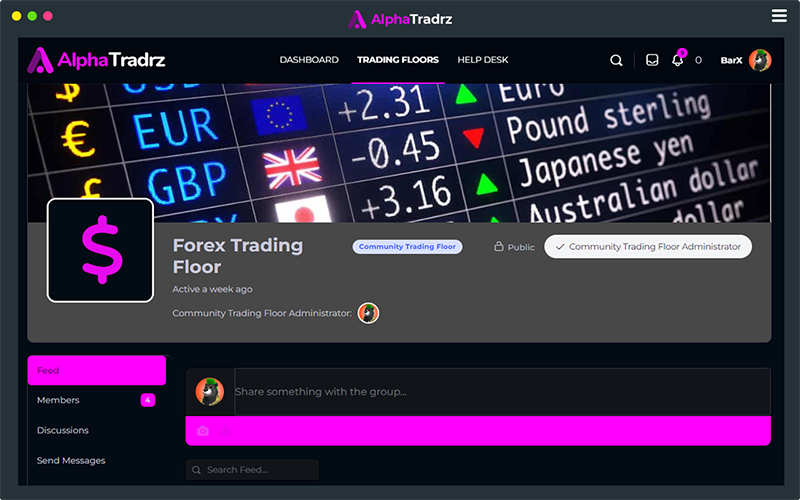FINANCIAL MARKET DAY TRADING
Investors!
Switch To Trading.
Get ready to short sell in 2024
Your Day Trading Support Platform.
Trading
Community
#DontTradeAlone
Join a trading group free and connect with other traders. Even create your own private groups.
Economic
Calendar
#EconomicCalendar
Ensure you know when the next data release is coming before trading.
Market
News
#MarketNews
Get the latest news and discover what's driving your market. Watchout for our AI news.
Market
Data
#MarketData
Get the latest prices from all the important markets and learn to read the markets.
Trading
Education
#TradingCourses
Learn to trade the Financial Markets, we connect you straight to professional trading educators.
Prop
Firms
#PropTrading
No longer do you need to trade and risk your own money. Take a Prop Challenge.
Retail
Brokers
#TradingBrokers
If you prefer to trade your own capital find find a broker that aligns with your trading strategy.
Help
Desk
#TraderSupport
We all need help. Use our Self Help resources or Join as a Pro Trader and get one on one help.
Upgrade To Pro
#TraderDashboard
This is the only paid feature on our platform, it is for those that want more, it provides trade setups and a daily trade process to identify high probability trades, whilst providing a dedicated one on one support through zoom and dedicated Trading Group.

#DontTradeAlone
FREE MEMBERSHIP
Self Help Support.
Our new day trading support platform provides a central platform for all traders to engage in conversations on the public groups, and access all the current market information from news, to current pricing across all asset classes.
Self Help Support includes:
- Public Trading Groups
- Economic Data Calendar
- Market News
- Market Data
- Trading Education
- Trader Funding
- Retail Brokers
- Self Help Support Desk
PROTRADER SUBSCRIPTION
ProTrader Subscription.
For those traders and investors that need a little more dedicated support.
ProTrader Subscription includes:
- Everything in the Free membership
- Trader Dashboard
- Support Zoom Calls
- Trade Setups
- Create Private Trading Groups
- Market Overview

#DontTradeAlone
Investor or Trader?
If you are a current Investor that buys and holds assets, you will know that the current market bullishness cannot go on forever without a major retracement. Having all your eggs in one basket is folly. Dedicate a small proportion of your investment portfolio to trading and benefit from short selling as well as hodling. Get it right and your ROI will skyrocket, get it wrong and you will only have lost a small proportion of your investment portfolio.
Use the leverage of not only CFD trading, but also the Prop Trading challenges that leverage your investment even more without the risk.
Investors
Waiting for your investment to go to the moon?
Try CFD trading and benefit from the bull market and the Bear Market, without investing.
CFD Trader
Are you an experienced trader?
Bring your trading experience and share with others.
Day Trading For Beginners
What is everyone talking about?
Learn to trade the financial markets and fix that retirement fund.

Ready to join
our new day trader support platform?
Frequently Asked Questions about Day Trading.
Day trading is a form of market trading where a trader buys and sells securities within the same trading day, with the aim of making profit from short-term price movements. This type of trading often involves high risk, as prices can be volatile and change rapidly. Day traders typically use technical analysis and chart patterns to make decisions, and they may employ leverage to amplify their gains. It is important to note that day trading requires a significant amount of time and attention, as well as a solid understanding of financial markets and a solid day trading strategy.
More often than not traders use CFD’s or Contracts For Difference to facilitate these trades.
Learning trading is very rewarding both financially and educationally. To get started trading, you can follow these steps:
- Educate yourself: Read books, articles, and watch videos to gain a solid understanding of financial markets, technical analysis, and day trading strategies.
- Create a trading plan: Define your trading goals, risk management strategies, and the types of securities you want to trade.
- Choose the best broker for day trading: Select a reputable broker that provides access to the markets you want to trade, with tools and resources to support your trading.
- Fund your account: Deposit money into your brokerage account to start trading.
- Practice with a demo account: Most brokerages offer demo or virtual trading accounts that allow you to practice trading with virtual money.
- Start small: Begin by trading with a small amount of money, and gradually increase your trading size as you gain experience and confidence.
- Monitor your trades: Keep a record of your trades, and regularly review and analyze your performance to identify areas for improvement.
Note: Trading can be risky and it is important to have a solid understanding of financial markets and a well-defined trading plan before starting. Additionally, it is advisable to seek professional advice and to never invest more money than you can afford to lose.
You might like to start using a Day Trading Simulator such as a Demo account where you are not using real money to trade with.
Trading buying power is the amount of purchasing power that a trader has to buy and sell securities on a given trading day. It is a measure of the maximum amount of capital that a trader can use to enter into new positions or increase the size of existing positions during the trading day.
The buying power of a trader is determined by the amount of cash and securities in their trading account, as well as the broker’s margin requirements and the trader’s own risk management strategy. In general, traders with larger account balances and higher levels of trading experience may have higher buying power, as they are able to meet margin requirements and manage risk more effectively.
Day Traders who use a margin account can often increase their buying power by borrowing money from their broker to invest in additional securities. However, margin trading involves significant risks, and traders should be aware of the risks involved and the terms and conditions of their margin account.
It is important for day traders to have a clear understanding of their buying power and to use it wisely to manage risk and maximize potential returns. This includes setting stop-loss orders, monitoring market conditions, and using technical and fundamental analysis to make informed trading decisions.
In summary, day trading buying power is the amount of capital that a trader has to buy and sell securities on a given trading day. It is determined by the trader’s account balance, margin requirements, and risk management strategy, and it is a key factor in managing risk and maximizing potential returns in day trading.
It is a type of trading in which traders buy and sell financial instruments, such as stocks, currencies, and futures, within a single trading day. The goal is to make a profit by taking advantage of small price movements in the market.
Here are the general steps involved:
Choose a trading platform: Traders need a platform that provides access to the markets they want to trade. There are many online brokers that offer trading platforms.
Develop a trading plan: Traders should have a well-defined trading plan that outlines their trading strategy, risk management rules, and investment goals.
Analyze the market: Traders use technical and/or fundamental analysis to identify potential trading opportunities. Technical analysis involves using charts and indicators to analyze price movements, while fundamental analysis involves analyzing economic and financial data to identify market trends.
Enter a trade: Traders enter a trade by buying or selling a financial instrument, based on their analysis and trading plan. They may use various trading strategies, such as scalping, swing trading, or trend following.
Manage the trade: Traders manage their trades by setting stop-loss orders to limit potential losses and taking profits when the price reaches their target.
Monitor the market: Traders need to stay up-to-date on market news and events that could impact their trades. They also need to monitor their trades in real-time and adjust their strategy if necessary.
Close out the trade: Traders close out their trades by selling or buying back the financial instrument they traded earlier in the day.
Trading can be a challenging and risky activity, as it involves making quick decisions and managing risk in a fast-paced and volatile market. Traders should carefully consider their risk tolerance and investment objectives before engaging in day trading, and they should develop a trading plan and strategy that works for them.
While it is possible to get rich day trading, it is a highly risky and challenging activity that requires a significant amount of skill and experience. Most day traders do not get rich, and many lose money or fail to earn significant profits over the long term. It is important for traders to carefully consider their risk tolerance and investment objectives before engaging in day trading and to approach it with caution and a well-defined trading plan.
The amount of money required for day trading can vary significantly depending on a number of factors, including the trading strategy used, the markets traded, and the trader’s risk tolerance. In general, most day traders need to have access to at least $25,000 in capital to meet the “pattern day trader” requirements set by the U.S. Securities and Exchange Commission (SEC).
Under the SEC’s rules, a “pattern day trader” is defined as someone who executes four or more “day trades” within a five-day period using a margin account. To meet the requirements of being a pattern day trader, the trader must maintain a minimum account balance of $25,000. This minimum account balance can be a combination of cash and securities.
It’s worth noting that while $25,000 is the minimum required by the SEC for day trading, many day traders may need more capital than this to execute their trading strategies effectively. This is because day trading involves taking on a significant amount of risk, and traders need to have enough capital to cover potential losses and margin requirements.
Ultimately, the amount of money needed for day trading will depend on the individual trader’s risk tolerance, trading style, and the markets they are trading. It’s important for traders to have a solid understanding of the risks and potential rewards of day trading, as well as a plan for managing risk and capital, before getting started.
If you do not have this amount of capital you can try one of the many prop trading firms. One of the most well known and respected Prop Trading Firms being Jane Street.
Day Trading
Day trading involves buying and selling financial instruments (such as stocks, options, currencies, or commodities) within a single trading day. Day traders aim to profit from short-term price movements, capitalizing on small price fluctuations. They open and close multiple positions throughout the day, often holding positions for just minutes or hours. The goal of day trading is to make quick profits by leveraging both upward and downward price movements.
Key characteristics of day trading:
1. **Short-Term Focus:** Day traders are primarily concerned with short-term price movements and do not hold positions overnight.
2. **High Frequency:** Day traders execute numerous trades within a single day, taking advantage of intraday price volatility.
3. **Technical Analysis:** Day traders heavily rely on technical analysis, using charts, patterns, and indicators to make trading decisions.
4. **Risk and Stress:** Day trading can be highly risky and stressful due to the rapid pace of trading and potential for losses.
5. **Capital and Leverage:** Day traders often use leverage to amplify their potential returns, but this also increases the risk of substantial losses.
Investing
Investing involves purchasing financial assets with the intention of holding them for an extended period, typically years or even decades. Investors aim to generate wealth over time through the appreciation of asset values and, in some cases, through dividends or interest payments. Investing is generally associated with a more conservative approach focused on long-term growth and building wealth over time.
Key characteristics of investing:
1. **Long-Term Focus:** Investors are interested in the long-term growth potential of their investments and are willing to weather short-term market fluctuations.
2. **Fundamental Analysis:** Investors often rely on fundamental analysis to evaluate the intrinsic value of an asset based on factors like earnings, assets, management, and market trends.
3. **Diversification:** Investors seek to diversify their portfolios across different asset classes (stocks, bonds, real estate, etc.) to manage risk.
4. **Lower Frequency:** Investors typically make fewer trades compared to day traders, as they hold positions for longer periods.
5. **Less Stressful:** Investing is generally considered less stressful than day trading since it involves less frequent decision-making and allows for longer-term strategies.
In summary, day trading involves frequent buying and selling of assets within a single trading day, with a focus on short-term price movements and technical analysis. Investing, on the other hand, entails holding assets for an extended period to achieve long-term growth and wealth accumulation, often relying on fundamental analysis and diversification strategies. Each approach has its own risks, benefits, and suitability depending on an individual’s financial goals, risk tolerance, and trading preferences.